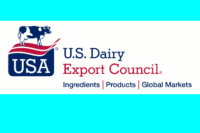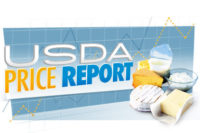Following are highlights from the USDA’s Dairy Market News for the week of June 15 to 19. Read the complete report, which includes the Organic Dairy Retail Overview and the National Retail Report.
With FDA banning trans fats, butter manufacturers eager to see what happens to demand
BUTTER HIGHLIGHTS: Central region, lighter in the East, and steady in the West. Some manufacturers are making and storing butter for future uses, while others are concentrating on current contracts. Inventory levels are mixed. Consumer demand continues to be strong. Cream supplies are tighter as ice cream and other high fat product producers continue to pull heavy. There are few spot loads available. This week, the FDA announced regulations banning trans fats, effective in three years. Butter manufacturers are eager to see what happens to butter demand. Friday at the CME Group, Grade AA butter closed at $1.9150, $.0150 above last Friday.
Western, Midwest cheese plants are running at capacity
CHEESE HIGHLIGHTS: Heavy milk supplies continue to push cheese production schedules across the nation. Many Western and Midwestern cheese plants are running at capacity, while Northeastern processors report steady production levels. There are still some reports of discounted loads of milk being available in the Midwest and West. Consumer cheese demand is fair to strong. Demand for foreign type cheeses in the United States is steady to firm. Imports of quota cheese from January through May is 78.0 million pounds, up 32% from last year. At the CME Group, Barrels closed Friday at $1.6600, down $.0625 from last Friday, and 40# blocks closed at $1.7000, down $.0550.
Temperatures affect milk production; milk bottling demand is down except in Northeast
FLUID MILK: Northeast farm milk output is heavy. Mid-Atlantic production is slowing due to higher temperatures and decreased cow comfort. The Southeast, Florida and California are seeing drops in production. Processors in Arizona are receiving milk loads from other states. Production rates in the Central region are increasing due to optimal cow comfort. Some manufacturers are utilizing surplus milk in any product lines with availability in production schedules. Spot loads are available at $3-5 under Class. Bottling demand is down, except in the Northeast where it has started to pick up. Demand is increasing as summer nears for dips and ice cream. Cream supplies are tighter than they have been.
Demand is lower for nonfat dry milk this week; condensed buttermilk rises because of ice cream makers
DRY PRODUCTS: Dry products have a weak undertone this week. Nonfat dry milk prices are steady to lower. Demand is lower. Spot sales are few and inventories are climbing. High heat prices are steady to lower. Stocks are light as producers are drying other products. Buttermilk prices are mixed in a weak market with little spot sales activity. Condensed buttermilk demand is steady to increasing as ice cream production continues to be strong. Dry whole milk prices are steady. Inventory levels vary. Dry whey prices are steady to lower in a weak market. Production remains steady due to cheese production volumes. Stocks on hand build as demand has decreased. There has been a lack of exporting due to the gap between domestic and foreign pricing. Whey protein concentrate prices shifted lower. Lactose prices are mixed. Holdings are higher than normal. Casein prices are unchanged.


